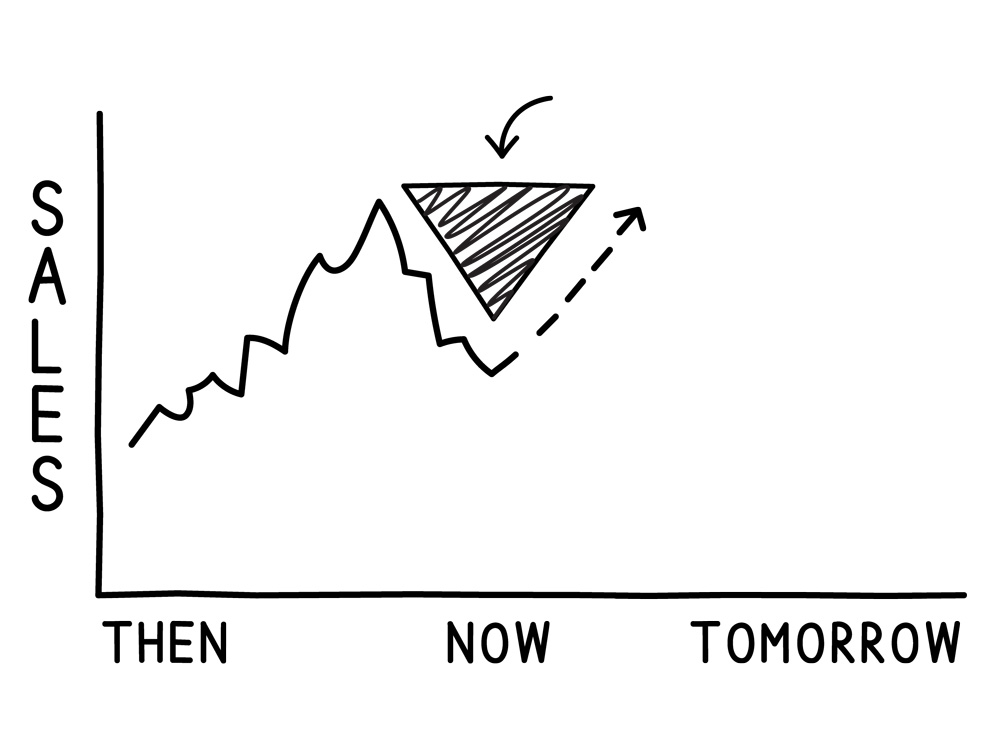|
This week I'm revisiting an old article because I had déjà vu in a conversation today. Someone telling me about the good old days in his business. Things have changed and he doesn't like it. Especially with the latest economic indicators swinging all over the place.
It felt like I had this exact conversation, years earlier. Me saying fixing your way to growth isn't going to happen. That's when I found this article. (and a few others I forgot about!) I didn't need to change much here, because, it turns out, I'm remarkably consistent. I said same thing this week, even using the same scribbles.
Let's go back to June 2013. . .

You Can't Fix Your Way To Growth
Excuse the blatant anonymizing here, but to protect the innocent I must generalize!
"Slim" and I were discussing business development efforts at his “dude ranch” and I thought he sounded suspiciously like he wasn’t talking about growth. He was talking about fixing an old problem. Trying to get back to “where things were” a few years ago.
You know. Before the economy went all to heck.
Slim is feeling like his group is not executing like they used to, so he wants my help to grow.
My issue is this: what Slim is talking about. . .it’s not growth.
What ensued was a classic “definition of terms” exchange. It is predicated on these two pictures I sent to Slim. ( the best cowboy name ever, btw)

Slim thinks that this delta (where my arrow is pointing) represents “growth” or “new business development”. I say it's really a “fix” that he’s talking about. He is still holding on to the trend line that was there before the hiccup. He is thinking about ways to get back to where he was, not growth.
So I sent this to him:

You may have seen this before, and right away you can tell it's not the same thing, right? The reason it’s not the same is that it’s built on the assumption that today is Slim's “new normal”, his plateau. It’s an analysis of Slim’s existing business development processes and isn’t imagining where Slim expected to be.
This topic is where we spent the most time.
When I think about growth, it’s based on what’s happening right now. Not back when. Not the best performing quarters from the last two years. Right now. I learned this working in the bank. They are experts at “re-forecasting” based on current results. It’s unsafe to ignore the past, but pretending like the future should be happening today, despite evidence things have changed, is equally unsafe. What Slim was prescribing for his group were “fixes” designed to get back to some previous results he planned for.
Things change. That stinks. The better we are at dealing with change, the better chance we have at growth.
Back to Slim. What seemed to get us on the same page was my statement that “you don’t fix your way to growth.” It broke him from holding on to his previously planned results. In reality, the dude ranch is simply different from 6 years ago. Lots of things are different. Facebook just opened to the public months before 2007. The iPhone came out in June 2007. Mad Gringo came online in 2007.
(note: I wrote this in 2013, those references seemed relevant)
My point is, if you’re not happy with current projections, start by looking carefully at where you are today. Be as exact as you can get. Then, in a separate exercise on a separate day, go to work on re-defining where the world will be, where your customers will be, and where you want to be in the next 5–7 years.
Slim has done an excellent job of reducing his fixed expenses while subtly changing his customer experience to fit into his new cost structure. His net is strong. Close to pre-recession levels. In my high-level view, Slim is already back. Fixed.
With this in mind, we got off Slim’s solutions for fixing the gap, and started talking about re-imagining outcomes. I think it's best if he centers on building on his team’s strengths.* Finding growth by focusing on what Slim’s team is good at.
A successful re-framing of expectations lets you get on with improving processes to set up the next period of growth. It happens. Swear.
*confirmation this idea was in my head years before "The Human Being's Guide to Business Growth" came out.
|